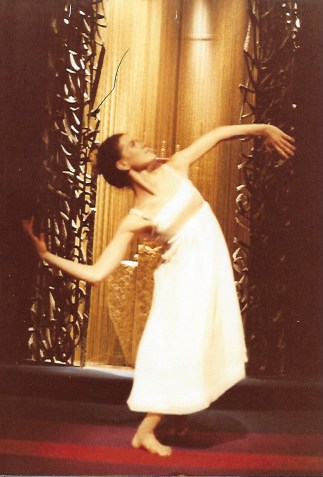Thirty children, along with a few parents, arrived at our home base of Hebrew Union College–Jewish Institute of Religion (HUC-JIR) on West 4thStreet in NYC to spend several hours with the Let My People Go Company. For five weeks, twice a week they participated in 45 minutes of dance and 45 minutes of music education, as well as journal writing, dinner and other short activities related to Let My People Go. The program culminated in a special sharing for parents and invited guests, where the children performed, celebrated at a special dinner and went home with souvenirs including a Let My People Go T-shirt, a rainstick, and books (generously donated by Scholastic Press) about music and Harriet Tubman.
We learned about the Cultural Arts Program for Children Living in Temporary Housing from H.T. Chen and Dian Dong, as we rented rehearsal space for a number of years from Chen and Dancers in Chinatown. They had received grants from the New York City Department of Cultural Affairs for several years and suggested we apply. We did and were thrilled to receive grants for the next several years until the program ended. It was one of the most satisfying teaching experiences that we had.
Kezia shared some of the experiences of the first year in Avodah’s December 1995 Newsletter:
The talking drum shouted with anger and then whispered a secret. The 12-year-old drummer had expressed her frustration clearly, without using a word. Words might come later, too, in her journal, but right now the drum was more satisfying, simultaneously announcing her feelings while keeping the specifics private.
Think of all the emotions, the alarms, the summonses, the celebrations, the unifying rhythms, the messages –throughout history, throughout the world – that have been spoken by drums. Nor did the power of the drum escape the attention of those who feared it; just as slaves in America were forbidden to learn to read, forbidden to gather, so too, their drums were taken away. But as the children who worked with our drummer, Newman Baker, would tell you, if you don’t have an actual drum in front of you, you always have one on you. And these children would further demonstrate for you the variations in tone when you slap the top of your thigh, pat the side of it, or tap your knee, all while beating complicated rhythms on this “hambone.”
It was during these programs that we witnessed Newman’s incredible talents teaching and I am thrilled to report that Newman continued to share his talents with Avodah as a regular collaborator and today continues as my very dear friend. You will be reading lots more about him as this blog continues.

Newman and Elizabeth teaching in a junior high school classroom. We often had grants to bring programs into the public schools.
All the company members proved to be excellent teachers beautifully guiding the children in various activities. For example, Loretta talked about Harriet Tubman and asked the children to go quietly from their lively school bus through a long lobby downstairs to their activity room as if they were fugitive slaves following Harriet Tubman on the Underground Railroad. Loretta, of course, became Harriet Tubman.

Loretta Abbott leading the children in the final presentation.
The facilities at HUC-JIR proved to be outstanding for the program. The large kitchen was ideal to make tasty and healthy dinners. Thank you, HUC-JIR, for making this possible. I learned that I could shop at BJ’s in Jersey City for large amounts of food at a reasonable price enabling me to add treats that the children were able to take home with them. For the first year, a former Avodah dancer, Peggy Evans (then a professional clown), coordinated the cooking. With classes, journal writing and eating together, the program flowed smoothly.

The Chapel at HUC-JIR was just perfect forthe dance classes and especially for the final presentation.
The director of the program for the New York City Department of Cultural Affairs was Rhonda McLean Nur. And much to our delight she sent Jeannine Otis to observe our work for the Department. We had met Jeannine before, when she appeared in a program that we had shared with Faith Journey at HUC. As we got to know Jeannine more, I kept thinking there had to be a way to collaborate with her. (See the next blog for how this came to be.)
In the second year of receiving the grant and developing a very strong relationship with the children, I arranged a field trip/reunion for the staff and children to attend a performance of the Broadway show Bring in ‘da Noise, Bring in ‘da Funk. While I don’t remember all the details of how we were able to pull this off, I believe the producers made special price tickets available to school groups for the matinee. It was exciting to have Savion Glover and other cast members talk to the children after the show.

Our field trip to see Bring in ‘da Noise, Bring in ‘da Funk.
Reflecting back on these unique teaching opportunities my heart again fills with the joy that we received from the children. They were eager and hungry to learn from us, and their enthusiasm brought out the very best in our teaching skills.
 Print This Post
Print This Post
Recent Blogs
- The Pioneers of Modern Dance: My Firsthand Experience
- A Visit to a Costa Rican Art Museum Triggers a Fascination with Mascaradas
- Thoughts after Streaming a Memorial for Dance Critic Jack Anderson
- Keeping Up With What is Happening in the Dance World
- A Sijo Poem for the Winter Solstice
- Episode 33: The Universal Dancer Podcast – I’m Interviewed by Leslie Zehr
- The National Symphony of Costa Rica
- Can you go home again?
- Odd Thing to Find on eBay
- Chopping in the Kitchen







